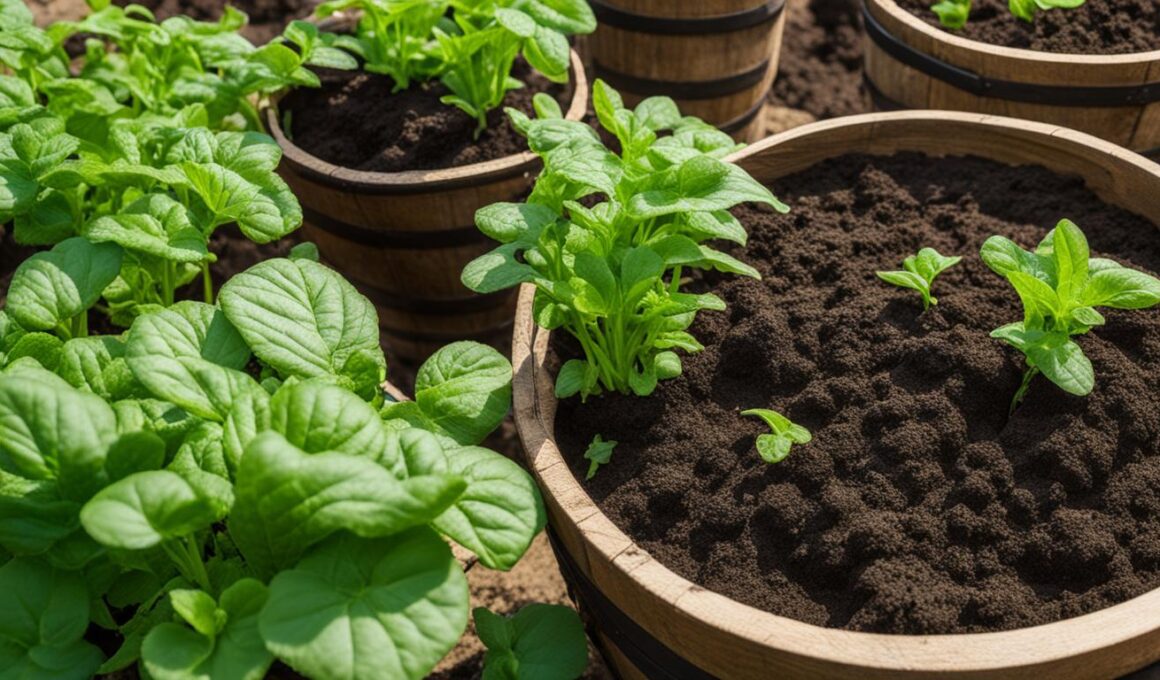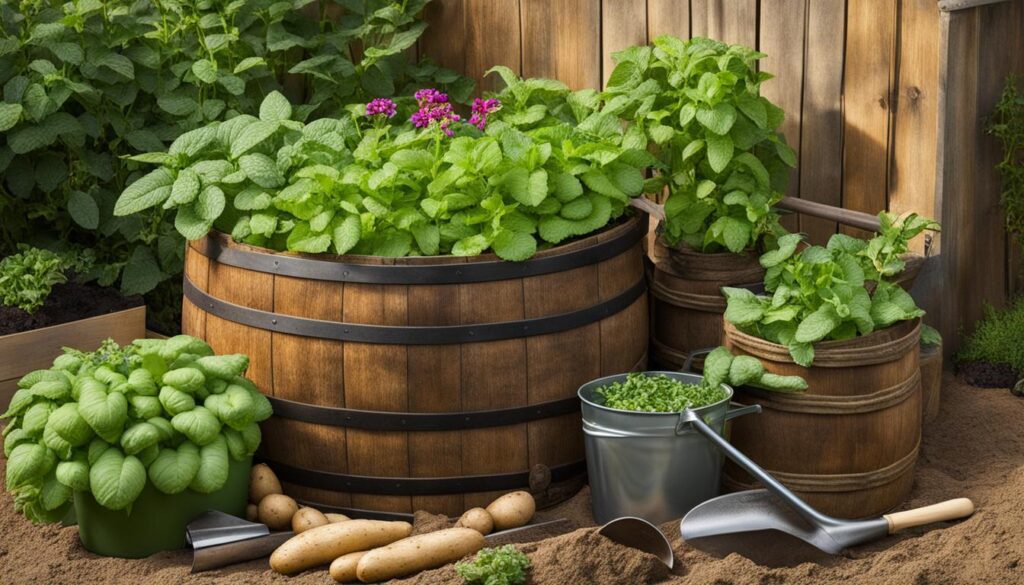Are you interested in growing your own potatoes but don’t have a large garden? Look no further – growing potatoes in a barrel is the perfect solution for you. It’s a simple and convenient way to enjoy a bountiful harvest of delicious spuds without requiring a lot of space. In this article, we will guide you through the easy steps and provide essential tips for successfully growing potatoes in a barrel.
Growing potatoes in a barrel offers several advantages. Firstly, it allows you to control the growing conditions, ensuring optimum soil quality and drainage. Secondly, it saves space as you can place the barrel on a patio, deck, or even a balcony. And finally, it adds a unique and rustic touch to your garden with the charming sight of potato plants peeking out from the barrel.
To get started, you’ll need to choose the right barrel for your potato-growing venture. Look for a large barrel with a capacity of about 55 gallons (210 L) and a height of at least 3-4 feet (0.91-1.22 m). Wooden barrels, like old whiskey barrels, are ideal choices as they provide excellent drainage and add aesthetic appeal. Avoid black barrels that can overheat in the sun and those previously used to store chemicals.
Before planting, it’s vital to clean the barrel with household bleach and water to ensure it’s free from any harmful substances or pathogens. Additionally, drill drainage holes in the bottom of the barrel to prevent waterlogging. You can further improve drainage by propping the barrel up on cinder blocks.
When it comes to selecting the potatoes and container, choose seed potatoes carefully. Look for sprouts and roots when purchasing them from a nursery. Alternatively, you can use organic potatoes from your local grocery store or farmers market, as long as they haven’t been treated with chemicals to prevent sprouting. For the container, you can opt for a specially designed potato grow bag or choose containers such as sturdy trash cans, storage totes, or whiskey barrels.
In the next section, we will delve into the details of choosing the right potatoes and container for your potato barrel. Read on to discover more about this exciting gardening method!
Choosing the Right Potatoes and Container
When growing potatoes in a barrel, it is important to choose the right potatoes and container. To begin, consider the type of potatoes you want to grow. Seed potatoes are the best choice as they are specifically grown for planting and provide consistent results. Look for seed potatoes that have sprouts and roots when selecting them from a nursery. These sprouts indicate that the potatoes are ready to be planted and will have a higher chance of successful growth.
Alternatively, you can also use organic potatoes from the grocery store or farmers market. However, make sure they have not been treated with chemicals to prevent sprouting. Using untreated organic potatoes allows for a more natural and healthier growth process.
Next, let’s talk about container options. There are various choices available, depending on your preference and availability. One popular option is a specially designed grow bag. These bags are specifically made for potato cultivation and offer excellent drainage, aeration, and portability. They are usually made from durable and UV-resistant fabric, which helps the potatoes thrive.
Another container option for growing potatoes is to repurpose items such as sturdy trash cans, storage totes, or whiskey barrels. These containers provide ample space for the potatoes to grow and can add a unique touch to your garden. However, it’s important to ensure that the chosen container has adequate drainage. This can be achieved by drilling holes in the bottom of the container, allowing excess water to escape and preventing waterlogging.
Now that you have an understanding of the right potatoes and container options, you are ready to move on to the next step of growing potatoes in a barrel. In the next section, we will discuss the planting process and how to care for your potato barrels to ensure a successful harvest.
Planting and Caring for Potato Barrels
To successfully grow potatoes in a barrel, it’s important to follow the proper planting and care techniques. By taking the necessary steps, you can ensure healthy growth and a bountiful harvest of your favorite tubers.
Begin by filling the container with a layer of potting soil and compost mix. This provides a nutrient-rich environment for your potatoes to thrive. Make sure to choose a high-quality soil mix that contains the necessary nutrients for optimal growth.
Next, place the seed potatoes on top of the soil mixture, ensuring the sprouts are facing up. Proper spacing is essential to allow each potato plant room to grow. Space them about 6 inches (15 cm) apart, giving each plant enough space to develop and access the necessary light and nutrients.
Once the potatoes are in place, cover them with soil, gently ensuring they are completely covered. Then, lightly water the soil, making sure it is damp but not soaking wet.
To provide the necessary nourishment for your growing potatoes, continue to add more soil, organic compost, or liquid fertilizer every 2-4 weeks. This additional nourishment will help the plants thrive and produce bigger, healthier potatoes. Nutrient-rich soil and regular feeding are key to achieving a successful harvest.
Watering is a crucial aspect of caring for potato barrels. While potatoes need regular watering, it’s important not to overwater them. Aim to keep the soil evenly moist, but avoid waterlogged conditions that can lead to root rot.
As the potato plants grow, check their height regularly. When the sprouts reach a height of 6-9 inches (15-23 cm), add more soil to the barrel. This process, known as “hilling,” helps promote additional tuber formation and prevents the potatoes from being exposed to light, which can cause greening and bitterness.
Repeat the hilling process until the barrel is almost full and the foliage has reached the top. Be mindful not to bury the plants completely, as they need access to sunlight for photosynthesis.
Continue to monitor the health and growth of your potato plants. Regularly inspect the leaves for signs of pests or diseases, and take appropriate action if necessary. Remove any dead or yellowing leaves to promote better air circulation and reduce the risk of fungal infections.
Finally, it’s time to harvest your potatoes! Wait until the plants have flowered and begun to wilt. This indicates that the tubers have reached maturity. Carefully dig into the soil and retrieve the potatoes, taking care not to damage them. Enjoy the fruits of your labor!
Conclusion
Growing potatoes in barrels is an easy and convenient way to have a bountiful harvest right in your own backyard. By following the simple steps and tips provided in this article, you can successfully grow delicious potatoes in a small space. The choice of the right container is crucial for optimal growth, with wooden barrels or specially designed grow bags being great options.
Proper care is important in ensuring the success of your potato crop. Regularly watering your potato plants and providing them with nourishment through organic compost or liquid fertilizer will help them thrive. Remember to avoid overwatering, as this can lead to rotting of the potatoes. With just a little effort and attention, you can enjoy a satisfying potato harvest without much space or effort.
When it’s time to harvest, simply tip the barrel over and dig out the potatoes. It’s as easy as that! You’ll be rewarded with a bountiful harvest of homegrown potatoes that are free from any chemicals or pesticides. Whether you’re a seasoned gardener or just starting out, growing potatoes in barrels is a rewarding and enjoyable gardening experience.
Can the same method be used to grow potatoes in a barrel and to propagate peonies?
Yes, it is possible to use the same method to grow potatoes in a barrel and to propagate peonies easily. Both can benefit from a well-draining, nutrient-rich soil, and proper spacing. The key is to ensure the proper conditions for each plant to thrive and produce a healthy crop or bloom.










